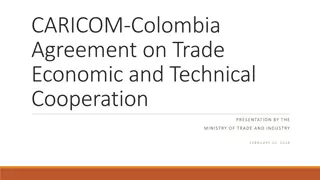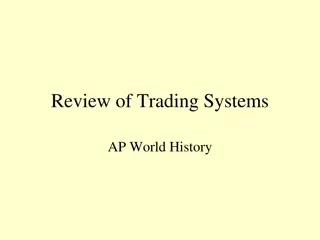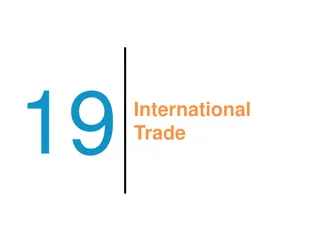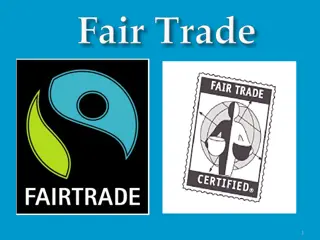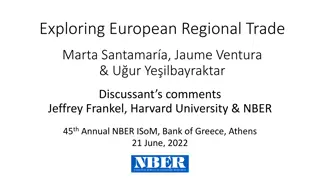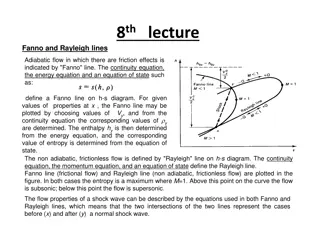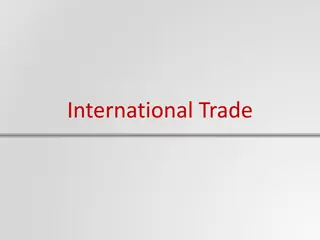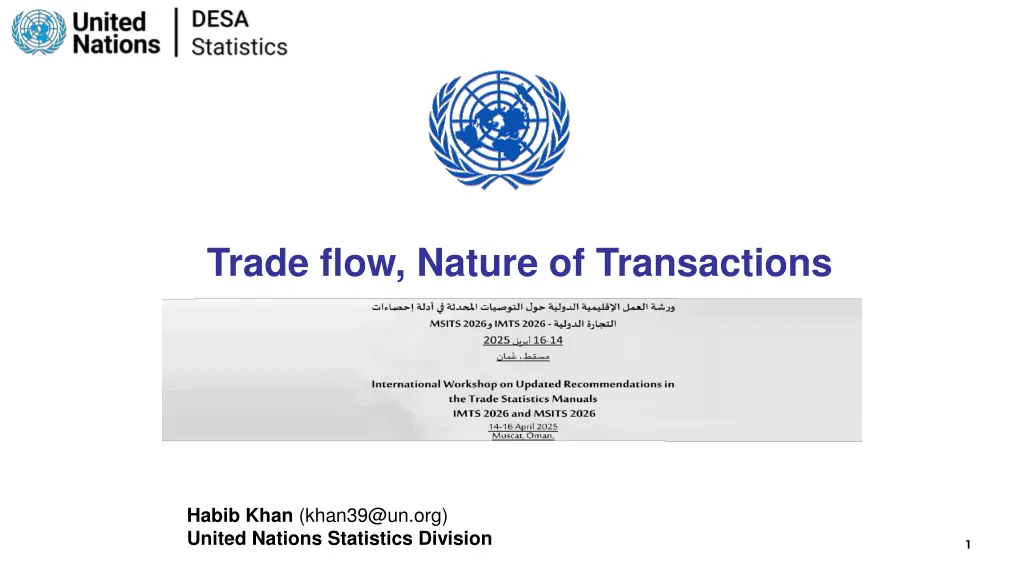
Understanding Trade Flow and Customs Procedure Codes
Explore the significance of trade flow and customs procedure codes in managing international transactions. Learn about the complexities, benefits, and efforts to harmonize codes at a global level for statistical use.
Download Presentation

Please find below an Image/Link to download the presentation.
The content on the website is provided AS IS for your information and personal use only. It may not be sold, licensed, or shared on other websites without obtaining consent from the author. If you encounter any issues during the download, it is possible that the publisher has removed the file from their server.
You are allowed to download the files provided on this website for personal or commercial use, subject to the condition that they are used lawfully. All files are the property of their respective owners.
The content on the website is provided AS IS for your information and personal use only. It may not be sold, licensed, or shared on other websites without obtaining consent from the author.
E N D
Presentation Transcript
Trade flow, Nature of Transactions Habib Khan (khan39@un.org) United Nations Statistics Division 1
Customs Procedure Codes (CPC) Used by Customs to describe flow of trade and nature of transaction It is used also to categorize special transaction on specific goods, trading partners, etc. It is mostly driven by the need to manage application customs duties i.e., inward processing procedure relives partly of fully customs duties
Temporary movement is to be excluded , but some cases can be complex Customs warehouse as storage? Leasing? Commercial samples? Goods for processing? Goods for repair/maintenance? as defined by statistical authorities of a country
CPC can be messy If not properly managed, CPC could grow into dozens or even hundreds codes, duplicating information about partner country, commodity classification, or others
But, CPC contains wealth of data Especially about the flow among territories (ref: presentation of movement of goods And nature of transaction, useful for compilers of balance of payments and for measuring globalization Also, for trade policy related statistics such as measuring the use of preferential duties after Free Trade Agreement
Attempt to Harmonize CPC at Global Level for Statistical Use Main classification based on RKC s Customs Procedure Codes The revised Kyoto Convention (RKC) was adopted in June 1999. The provisions contained in the RKC aim at the facilitation of trade but at the same time make customs records a highly standardized and reliable data source for trade statistics across countries. IMTS 2010 CM Para. 2.6 Memorandum Items, consists of combination of (all or part of) CPCs
Mapping National CPC to Global CPC and Trade Flow FLOW DOMESTIC EXPORTS DOMESTIC EXPORTS IMPORTS IMPORTS IMPORTS IMPORTS IMPORTS RE-EXPORTS CPC CODE 1000477 Export of Goods (Direct).---.Suspension of export duty on maize corn (as per si 21 of 2017) 1072000 Export Goods from bonded warehouse.---.Common regime 4000407 Entry for Home use (General).---.Goods for Approved Companies under Regulation 91,91A & 92. 4000412 Entry for Home use (General).---.Goods under Duty relief on specific SI approved by the Minister. 4055000 Entry for Home use after temporary import for Accompanied Baggage.---.Common regime 4080405 Entry for Home Use After R.I.B.---.Goods for the Government of the Republic of Zambia. 4083420 Entry for Home use - from non automated station.---.Goods for Government Agencies. 1040102 Export of Goods after entry for home use.---.Export of goods liable to Duty Drawback. CPC CODE DESCRIPTION UNSD CPC Code UNSD Description 3 Outright exportation 3 Outright exportation 1 Clearance for home use 1 Clearance for home use 1 Clearance for home use 1 Clearance for home use 1 Clearance for home use 8 Drawback
Nature of transaction (NoT) New data item which complements CPC Captures purpose of the goods movement; transfer of ownership; financial compensation Unlike CPC, NoT codes are statistical in nature What The main purpose is to enable correct transition from IMTS to BoP and NA Other analytical uses (e.g. information on FGP setup) Why
Factoryless Goods Producer (FGP) Recording in country B: Import from C = Of which: goods sold by or bought from a factoryless goods producer/principal with a view to contract manufacturing Export to D = Of which: goods sold to or bought by a factoryless goods producer/principal after contract manufacturing
Factoryless Goods Producer (FGP) Recording in country B: Import from A = Of which: goods sold by or bought from a factoryless goods producer/principal with a view to contract manufacturing Export to A = Of which: goods sold to or bought by a factoryless goods producer/principal after contract manufacturing
Factoryless Goods Producer (FGP) Recording in country A: Export to B = Of which: goods sold by or bought from a factoryless goods producer/principal with a view to contract manufacturing Import from B = Of which: goods sold to or bought by a factoryless goods producer/principal after contract manufacturing
Warehousing Proposal: Include both bonded warehouses and distribution centers Recording of warehouse trade on both A and B
Warehousing Recording in A: Export to B: Of which: Goods exported by a resident to warehouse abroad or imported by a non-resident into a warehouse in the compiling economy Recording in B: Import from A: Of which: Goods exported by a resident to warehouse abroad or imported by a non-resident into a warehouse in the compiling economy Export to C: Of which: Goods exported by a non-resident from a warehouse in the compiling economy or imported by a resident from a warehouse abroad
Warehousing Recording in A: Export to B: Of which: Goods exported by a resident to warehouse abroad or imported by a non-resident into a warehouse in the compiling economy Import from B: Of which: Goods exported by a non-resident from a warehouse in the compiling economy or imported by a resident from a warehouse abroad Recording in B: Import from A: Of which: Goods exported by a resident to warehouse abroad or imported by a non-resident into a warehouse in the compiling economy Export to A: Of which: Goods exported by a non-resident from a warehouse in the compiling economy or imported by a resident from a warehouse abroad
Questions Do we need an Other category? How difficult would it be to compile NoT codes? Other questions?






